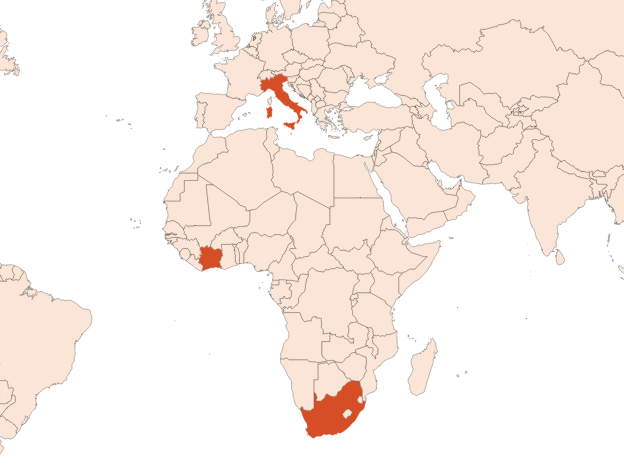
| Company | Ingredient Name | ID | Comments | Naturality | Certifications | Purity | Latin name | Treated part | Geographical origin | MOQ |
|---|---|---|---|---|---|---|---|---|---|---|
|
|
Huile essentielle de Bergamote - 30 gr | - |
Visit website
|
- | - | - | - | - | - | |
|
|
BERGAMOT Essential Oil | M_0020356 |
Visit website
|
Naturel | - | - | - | - | - | |
|
|
BERGAMOT Rectified Essential Oil | M_0063590 |
Visit website
|
Naturel | - | - | - | - | - | |
|
|
BERGAMOTE | B120 |
Visit website
|
Huile essentielle |

|
- | Citrus bergamia Risso et Poiteau | Zeste | Italie | - |
|
|
BERGAMOTE SANS BERGAPTENE | B123 |
Visit website
|
Huile essentielle |

|
- | Citrus bergamia Risso et Poiteau | Zeste | Italie | - |
General Presentation
-
CAS N° : 8007-75-8
-
EINECS number : 296-429-8
-
FEMA number : 2153
-
Appearance : Pale yellow to green liquid
-
Density : 0,876 - 0,883
-
Volatility : Head
-
Price Range : €€
Physico-chemical properties
-
Optical rotation : Donnée indisponible
-
Vapor pressure : Donnée indisponible
-
Refractive Index @20°C : Donnée indisponible
-
Acid Value :
-
Flash Point :
Uses
Uses in perfumery :
Used in eaux fraîches, colognes, chypre accords (with Bergamote EO, Patchouli EO, Cistus EO, Cistus Labdanum Absolute Green and Oak Moss Absolute). Brings freshness to the head and lightens oriental notes.
Major Components :
- D-Limonene (35-40%)
- Linalyl Acetate (25-30%)
- Linalool (≈20%)
- Gamma-Terpinene (≈6%)
- Beta-Pinene (≈4%)
- Sabinene (≈4%)

Photo credits: ScenTree SAS
Botanical name :
Citrus ×limon (L.) Burm.fil.
Synonyms : Citrus aurantium subsp. bergamia (Risso) Wight & Arn. // Citrus aurantium var. bergamia (Risso) Brandis
Botanical profile :
Bergamot is the fruit of the bergamot tree, belonging to the Rutaceae family and the Citrus genus.
Chemotypes :
The genus Citrus includes the vast majority of citrus fruits and includes a large number of varieties available in perfumery:
Bergamot - (Citrus bergamia) is a hybrid of lemon and bitter orange, grown for the essential oil of its fruit and petitgrain.
Bitter orange or bigarade orange - (Citrus aurantium), grown in Spain and Florida.
Citron - (Citrus medica), grown in Italy (Sicily).
Lemon - (Citrus limon), cultured in Italy for the essential oil of its fruit and of its leafy twigs (Petitgrain).
Combava - (Citrus hystrix), grown in Thailand and India.
Lime - (Citrus aurantifolia), grown for its fruit in Mexico for the most part.
Mandarin - (Citrus reticulata), grown mainly in Italy for its fruit and for its petitgrain, by extracting the leaves from the tree. Its hybrid with sweet orange gave birth to clementine.
Orange - (Citrus sinensis) is famous for the cultivation of its fruits, whose juice and essential oil are extracted in Brazil and California in particular, which is the most used of all perfumes.
Grapefruit - (Citrus paradisii) of Malay origin, is cultivated for its essential oil in Brazil and Israel in particular.
Yuzu - (Citrus junos), produced in Japan and Korea.
Extraction process :
Bergamot comes from the bergamot tree. First green then yellow, it is a citrus of about 80 to 200 grams. The harvest, done by hand (fruits are very sensitive), begins in November and ends around the end of January. The bergamots are stored for 2 to 3 days to warm them and soften the zest.
After that, the fruit is put in a sfumatrice to extract the essential oil (cold expression). The sfumatrice works by pricking all the zest of the fruit with needles in order to collect the essential oil and the zest debris. Then these two parts are washed away by a stream of water to a centrifuge. The purpose is to separate the oil from the water and the debris from the peel. Once this separation is done, the essential oil of raw bergamot is collected. The oil can also be obtained by separating the zest of the fruit in a peeler machine and by steam distilling the zest. This essential oil is called ''distilled bergamot '' or ''Cold expressed Bergamot ''.
The cold expression yield is approximately 0.5%.
An extraction with a volatile solvent gives a yield of 4%. The essential oil must be rectified to remove the bergaptenens, which are photosensitizers. This rectification can also be used to isolate terpenes or other compounds from the bergamot.
The oul quality varies according to the harvest months: more floral in November (higher presence of linalool) and cooler in January (higher presence of linalyl acetate). There is also a ''black bergamot '' which is an extraction of the zest of an overripe fruit fallen from the tree during the winter whose zest has become black.
Other comments :
The essential oil of bergamot is often called ''bergapten-free '' as the oil used in perfumery can only be used once all the bergaptenes has been removed.
Citrus currently suffer from a disease called ''citrus greening ''. This disease is deadly for citrus fruits and no treatment exists. It is transmitted by a vector insect that attacks young shoots: the psylla. This results in the premature death of many trees and therefore the decline in the general production of the essential oil and its quality (reduction of the Limonene level).
Stability :
Solubility issues in perfumes
Citruses tend to fade through time in perfumes
Limonene tends to convert into Carvone through time, and to give a minthy note to the oil
The esters identified in this raw material can form their corresponding acid in stability tests
The terpenes identified in this raw material can polymerize when they are oxidized
Regulations & IFRA
Allergens :
IFRA 51th :
This ingredient is restricted by the 51th amendment
- Quantitative limit on the use :
-
Cat.1 Cat.2 Cat.3 Cat.4 Cat.5A B C DCat.6 0,4 % 0,4 % 0,4 % 0,4 % 0,4 % 0,4 % 0,4 % 0,4 %0,4 % Cat.5A B C DCat.6 0,4 % 0,4 % 0,4 % 0,4 %0,4 % Cat.7A BCat.8 Cat.9 Cat.10A BCat.11A BCat.12 No Restriction 0,4 %0,4 % No Restriction No Restriction 0,4 %No Restriction 0,4 %No Restriction Cat.10A BCat.11A BCat.12 No Restriction 0,4 %No Restriction 0,4 %No Restriction
Annexe I :
Some regulated synthetic ingredients are found in nature and in certain proportions in natural ingredients. This presence in nature has to be taken into account when calculating limits of use recommended by the IFRA. In case you do not know these concentrations, you can use the ones estimated by the IFRA. Here they are :
| List of regulated compounds contained in this ingredient | ||
|---|---|---|
| Regulated ingredient name | CAS N° | Estimated Concentration |
| Geraniol | 106-24-1 | 0,04 |
| Geranial | 141-27-5 | 0,28 |
| Neral | 106-26-3 | 0,2 |
-
Restricted ingredients due to phototoxicity considerations: notes
The Standard is set due to the phototoxic effects of Bergamot oil expressed. For more detailed information on the application of this Standard, please refer to the note on phototoxic ingredients in Chapter 1 of the Guidance for the use of IFRA Standards. If the level of furocoumarins is unknown, the restriction level specified in this IFRA Standard applies. Combination effects of phototoxic ingredients are only taken into consideration for the furocoumarin-containing fragrance ingredients (extracts) listed in the IFRA Standard of Citrus oils and other furocoumarins containing essential oils. If combinations of furocoumarin-containing phototoxic fragrance ingredients (extracts) are used, the use levels must be reduced accordingly. The sum of the concentrations of all furocoumarin-containing phototoxic fragrance ingredients (extracts), expressed in of their recommended upper concentration level in the consumer product shall not exceed 100. For qualities of the expressed oil in which the less volatile components have been concentrated by partial or total removal of the terpene fraction, this limit should be reduced in proportion to the degree of concentration.



